royal perth hospital student training ward - Health Sciences - Curtin ...
royal perth hospital student training ward - Health Sciences - Curtin ...
royal perth hospital student training ward - Health Sciences - Curtin ...
Create successful ePaper yourself
Turn your PDF publications into a flip-book with our unique Google optimized e-Paper software.
REPORT<br />
ROYAL PERTH HOSPITAL<br />
STUDENT TRAINING WARD
REPORT<br />
ROYAL PERTH HOSPITAL<br />
STUDENT TRAINING WARD<br />
I<br />
n collaboration with <strong>Curtin</strong> University, Royal Perth<br />
Hospital (RPH) played host to the first interprofessional<br />
<strong>student</strong> <strong>training</strong> <strong>ward</strong> in the southern hemisphere. The<br />
project was modelled on the highly successful <strong>training</strong><br />
<strong>ward</strong>s that have operated in Europe for the past two<br />
decades, which have demonstrated that <strong>student</strong>s who<br />
participate in such a learning experience:<br />
gain an ability to collaborate effectively through an<br />
increased understanding and appreciation of each<br />
other’s profession;<br />
develop their own professional competence and role in<br />
the healthcare team;<br />
develop efficient and effective practices in the<br />
identification of the patient’s needs so as to plan,<br />
implement and evaluate evidence based care;<br />
understand the role of the patient in their care;<br />
are highly attractive to employers; and<br />
as new graduates, are more confident in their<br />
interprofessional competencies whilst having an<br />
appropriate level of confidence in their clinical skills.<br />
Six beds within a 26–bed general medical <strong>ward</strong> provided the<br />
setting for three consecutive 2-week clinical placements for<br />
health science <strong>student</strong>s from nursing, physiotherapy,<br />
occupational therapy, social work, pharmacy and medicine.<br />
The <strong>student</strong>s were supervised five days a week on morning<br />
shifts.<br />
The <strong>ward</strong> provided an authentic, practice-based learning<br />
environment where undergraduate <strong>student</strong>s developed the<br />
knowledge, skills and attitudes required for effective<br />
patient-centred collaborative practice. The key focus was<br />
the application of interprofessional education (IPE)<br />
principles to the delivery of holistic patient care, with an<br />
emphasis on teamwork during patient contact, handover<br />
and discharge planning. The <strong>student</strong>s were also required to<br />
demonstrate an increased level of independence as they<br />
undertook the <strong>ward</strong> duties as a team.<br />
Facilitators from social work, physiotherapy, occupational<br />
therapy, pharmacy and medicine were rostered on for part<br />
of each day. A nursing facilitator was on the <strong>ward</strong> full time.<br />
A consumer advocate visited the <strong>ward</strong> once per week to<br />
listen to patients and to provide feedback to the <strong>student</strong>s.<br />
All <strong>student</strong>s (except medicine) and the nurse facilitator<br />
commenced each day at 0700 and began with handover<br />
from the night shift nursing staff. The <strong>student</strong>s then<br />
completed the medication round and prepared patients for<br />
breakfast. The medical <strong>student</strong>s joined five members of the<br />
<strong>student</strong> team at 0800 on the <strong>ward</strong> round whilst two<br />
<strong>student</strong>s remained on the <strong>ward</strong> to care for the patients.<br />
Following the <strong>ward</strong> round <strong>student</strong>s met with their<br />
profession-specific facilitator (an RPH staff member from<br />
their profession) to discuss each patient and to clarify the<br />
profession-specific tasks the <strong>student</strong>s were to undertake<br />
that day. This also provided the opportunity for <strong>student</strong>s to<br />
request assistance with any task they felt they could not<br />
undertake without profession-specific support/supervision.<br />
Group planning meetings followed, led by a different<br />
facilitator each day. For example, on Monday the medical<br />
facilitator led the meeting while on Tuesday this was the<br />
pharmacy facilitator.<br />
Students then undertook further patient care activities,<br />
including handover of the patients to the afternoon shift.<br />
Other activities included professional development and<br />
research. Each day ended with a half hour debrief led by<br />
one of the staff facilitators.<br />
Student Assessment<br />
Student’s interprofessional capabilities were assessed<br />
using a tool <strong>Curtin</strong> developed, the Interprofessional<br />
Capability Assessment Tool (ICAT). This tool has a 4-point<br />
Likert scale: unsatisfactory, satisfactory, developing and<br />
outstanding with a rubric to describe each capability at<br />
each level. Examples of the interprofessional capabilities<br />
include the ability to:<br />
communicate effectively in a respectful manner;<br />
establish and maintain effective working relationships;<br />
demonstrate confidence in understanding their own role<br />
as well as others;<br />
reflect on team structure, function and roles; and<br />
participate in and lead team meetings.<br />
Each <strong>student</strong> received both profession-specific supervision<br />
and interprofessional supervision (supervision by staff from<br />
a profession other than their own). As a result of this<br />
shared model of supervision each <strong>student</strong>’s<br />
interprofessional capabilities assessment was completed<br />
by the nurse facilitator with input from the other<br />
facilitators. Students were also required to rate themselves<br />
using this tool. All <strong>student</strong>s achieved a pass grade for their<br />
interprofessional placement with most capabilities rated at<br />
a satisfactory or outstanding level at the completion of<br />
the placement. Comments were typified by the following<br />
examples:-<br />
“(Student) was an avid participant in team discussions<br />
actively listening to her team members but always<br />
offering constructive input from a social work point of<br />
view.”<br />
“(Student) ensures that patient safety is her number one<br />
priority.”<br />
In addition to the interprofessional capabilities assessment,<br />
<strong>student</strong>s were asked to provide feedback to their peers in<br />
terms of their collaborative skills using a peer evaluation<br />
tool <strong>Curtin</strong> developed. This asked <strong>student</strong>s to rate<br />
behaviours on a 5-point Likert scale from very poor to<br />
excellent. The results are summarised in Table 1 (over).
REPORT<br />
Table 1: Summary of Peer Evaluations<br />
Item Median Mean SD<br />
% Rated<br />
Good or<br />
Excellent<br />
Actively listens to the knowledge & opinions of other team members 5 4.69 0.510 97.6<br />
Respects the competence & contribution of other professions to patient care 5 4.73 0.493 97.6<br />
Effectively communicates own profession's role in a way that promotes positive<br />
interaction<br />
5 4.68 0.585 96.8<br />
Effectively communicates knowledge in a way that promotes positive interaction 5 4.68 0.560 96.8<br />
Works collaboratively with team members to provide safe, high quality patientcentered<br />
care<br />
5 4.69 0.568 97.6<br />
Actively engages in team meetings 5 4.64 0.555 96.0<br />
Actively engages in reflection on team structure, function & roles 5 4.56 0.542 97.6<br />
NB – Median reported as primary central tendency when item data<br />
is ordinal.<br />
The table clearly shows that the <strong>student</strong>s most frequently<br />
rated their peers as good or excellent collaborators.<br />
“He was really eager to learn about other professions as<br />
well as share his knowledge.”<br />
“(Student) appears confident in her role and knowledge,<br />
resulting in clear communication with patients and team<br />
members.”<br />
Evaluation of the Placement<br />
In keeping with the scholarly approach to our<br />
interprofessional education initiatives, all stakeholders<br />
involved in the <strong>training</strong> <strong>ward</strong> were invited to complete<br />
quantitative and/or qualitative tools to measure the<br />
outcomes of the experience.<br />
showed statistically significant changes and large effect<br />
sizes. The results are summarised in Table 2.<br />
Students were asked to give a general rating on a 5-point<br />
Likert scale of their pre and post placement knowledge of<br />
their own as well as other professions, the patient’s role,<br />
the importance of communication and their own comfort in<br />
collaborating within the health care team. As you can see<br />
from Figure 1 <strong>student</strong>’s knowledge of their own profession<br />
and of the other professions increased dramatically<br />
following this short but intense placement. Their knowledge<br />
of the role of the patient in their own care and of the<br />
importance of communication to patient safety and quality<br />
also improved. All <strong>student</strong>s reported feeling comfort in<br />
collaborating with the other professions at the end of the<br />
placement.<br />
Figure 1: Summary of Students’ Post-Placement IPE Knowledge<br />
Students<br />
The quantitative tool used was the Interprofessional<br />
Socialisation and Valuing Scale [ISVS] (King, Shaw &<br />
Orchard, 2009). This tool has three subscales which<br />
measure the <strong>student</strong>s’ ability and comfort in working with<br />
others and the value they place on this. A paired sample t<br />
test was used to compare pre and post placement scores<br />
for all 21 <strong>student</strong>s who participated in the pilot. On<br />
average, the <strong>student</strong>s’ post placement ISVS scores were<br />
19.55 points better than their pre placement scores. This<br />
difference indicated a more positive attitude to<br />
collaborative practice post placement and was statistically<br />
significant with follow up analysis showing a large effect<br />
size.<br />
Three paired sample t tests were also used to compare the<br />
difference of each of the three sub-scales of the ISVS before<br />
and after the placement. A statistical correction was made<br />
to account for the repeated t tests, and all three sub-factors<br />
Table 2: Student ISVS Subscale Results<br />
Subscales<br />
Mean<br />
change<br />
Students were also asked to rate their overall experience on<br />
a single item 5-point Likert scale ranging from 1 (very poor)<br />
to 5 (excellent). Quantitative results indicated that 100% of<br />
<strong>student</strong>s rated this learning experience as good or excellent.<br />
t df p d Effect Size<br />
Ability to work with others 6.00 5.45 20
Quantitative comments revealed that:<br />
Nineteen out of 20 <strong>student</strong>s highlighted the knowledge of<br />
the roles and responsibilities of other health professions<br />
they had gained within the placement. One specific element<br />
they found particularly useful was a greater understanding<br />
of the assessments or skills specific to a particular<br />
discipline. This was reinforced by staff who drew attention<br />
to the increased understanding that <strong>student</strong>s gained of the<br />
roles and responsibilities of other healthcare professionals.<br />
Responses from <strong>student</strong>s concerning patient-centred care<br />
emphasized that all the professions collaborated to provide<br />
the best and most holistic care for the patient. In<br />
considering the patient as an individual with wants and<br />
needs at times conflict arose in addressing both of these.<br />
Associated with this was the awareness that a large<br />
number of these conflicts between patients’ needs and<br />
wants were avoided or mitigated through effective<br />
communication and rapport with the patient, something<br />
that all <strong>student</strong> teams felt was particularly important.<br />
Students reported that investing time and effort to develop<br />
a good rapport with patients and keeping them involved<br />
and informed in their treatment meant that the patients<br />
were very motivated and cooperative. Comments included:<br />
“All patients mentioned they felt more cared for and that<br />
we were more thorough than on other <strong>ward</strong>s. They felt<br />
their needs were attended to more rapidly and that they<br />
got benefit of all professions. Even when patients didn't<br />
need certain things done, they could see the level of care<br />
that others were getting and that reassured them.”<br />
“Having a combined assessment meant that the patient<br />
didn't have to repeat themselves many times to different<br />
disciplines.”<br />
“I feel the patients also gained a greater insight into the<br />
different professions and could see that we were working<br />
together to provide the highest quality patient centred<br />
care.”<br />
“The STW was great for me and I hope it continues for a<br />
long time.”<br />
“I had an immensely enjoyable time, discovering other<br />
professions, meeting the other <strong>student</strong>s and sharing time<br />
with them. I would not hesitate to recommend the<br />
opportunity to anyone!!!”<br />
“I loved this experience and wish I had more of it during<br />
my clinical placements.”<br />
Students highlighted the value and importance of<br />
collaboration in this placement, with many emphasising<br />
that effective communication was particularly important.<br />
As a subcategory to this some <strong>student</strong>s stressed that it<br />
was important to ask for help when needed. This was again<br />
supported by staff who drew attention to the benefits of<br />
effective communication. When <strong>student</strong>s compared this<br />
experience to other placements that had taken place with<br />
differing professions, they remarked that in the <strong>training</strong><br />
<strong>ward</strong> the different professions really worked as a team and<br />
communicated equally with each other.<br />
When asked about the skills they could transfer to other<br />
environments, <strong>student</strong>s commented that the knowledge of<br />
roles and responsibilities gained both within and between<br />
professions, together with the understanding of what was<br />
involved in the operation of a general medical <strong>ward</strong>, was<br />
invaluable. They felt that this knowledge would be<br />
applicable to some extent regardless of where they practice.<br />
Staff<br />
Staff completed a qualitative and quantitative survey, pre<br />
and post placement, and attended an interview at the<br />
conclusion of the pilots. Eighty per cent of staff rated their<br />
overall experience in the <strong>ward</strong> as good or excellent.<br />
They were asked to rate a number of items designed to<br />
measure their attitude and ability with regards to IPE<br />
facilitation on a 5-point Likert scale (1 = very poor to 5 =<br />
excellent), Descriptive analysis showed that following the<br />
placements, most staff were very motivated and confident<br />
to facilitate IPE. Their knowledge of strategies, ability to<br />
provide feedback and to model interprofessional practice<br />
varied from average to excellent. A summary of this is<br />
provided in Table 3. Comments included:-<br />
“From the facilitator’s perspective, I have thoroughly<br />
enjoyed being involved in the STW experience. I hope the<br />
STW becomes a sustainable program as I see it being<br />
very beneficial to <strong>student</strong>s in preparing them for the ‘real<br />
world’.”<br />
“By <strong>training</strong> <strong>student</strong>s in an ‘ideal’ environment and<br />
encouraging multidisciplinary team collaboration and<br />
understanding, the organisation will benefit, as a better<br />
service will be provided to consumers when the <strong>student</strong>s<br />
graduate & enter the workforce.”<br />
“Patients received the comprehensive input of the whole<br />
team & often reported they felt more understood &<br />
listened to.”<br />
“Students were able to relate practice to theory in earlier<br />
stages. Even doctors were able to have hands on with<br />
direct patient care.”<br />
“Medically speaking, our workload was reduced as the<br />
<strong>student</strong>s were efficient and completed all tasks.”<br />
“Staff resources are not stretched as there are more<br />
hands on deck.”<br />
“This STW is an excellent and fantastic learning<br />
opportunity for all <strong>student</strong>s. I highly recommend it.”<br />
Table 3: Summary of IPE Staff Attitudes and Abilities<br />
Item Median Mean SD % Rated<br />
Good or<br />
Excellent<br />
% rated<br />
Average<br />
% Rated<br />
Poor or<br />
Very Poor<br />
Motivation to facilitate interprofessional education 4.0 4.07 .730 78.6 21.4 0<br />
Confidence to facilitate interprofessional education 4.0 4.00 .679 78.6 21.4 0<br />
Knowledge of strategies to facilitate interprofessional<br />
education<br />
Ability to provide appropriate feedback to <strong>student</strong>s from<br />
different professions<br />
Ability to model collaborative practice (interprofessional<br />
practice)<br />
4.0 3.75 .700 64.3 35.7 0<br />
4.0 3.86 .770 64.3 35.7 0<br />
4.0 3.85 .770 64.3 35.7 0
REPORT<br />
Patients and/or Carers<br />
The consumer advocate on the <strong>student</strong> <strong>training</strong> <strong>ward</strong><br />
interviewed the patients each week and provided feedback<br />
on this to the <strong>student</strong>s along with a written report to staff.<br />
Formal patient satisfaction surveys were also provided<br />
consisting of questions about their experience with both<br />
staff and <strong>student</strong>s on the <strong>ward</strong>. Ratings were on a 5-point<br />
Likert from very dissatisfied to very satisfied. Fourteen<br />
completed surveys were analysed and revealed that the<br />
vast majority of patients were happy with the care they<br />
received as indicated in Table 4.<br />
Table 4: Summary of patient survey<br />
All <strong>student</strong>s commence each shift at the same time<br />
Reduced external commitments such as days <strong>student</strong>s<br />
are required to be at university as these detracted both<br />
from the learning experience and the team’s ability to<br />
function effectively<br />
Inclusion of an extra medical <strong>student</strong> to reduce the<br />
workload and allow them to be present for more of the<br />
group activities (Note: It was also pointed out that one<br />
very useful experience that the medical <strong>student</strong>s gained<br />
from this placement was learning to deal with being<br />
overwhelmed, as this reflected their practice in real life)<br />
Patient Survey Question Median Mode SD<br />
% Rated<br />
Satisfied or<br />
Very satisfied<br />
How would you rate your overall experience in the <strong>student</strong> <strong>training</strong> <strong>ward</strong> 5 4.50 .674 91.7<br />
The <strong>student</strong>s were courteous and treated you with respect. 4 4.38 .506 100<br />
How well the <strong>student</strong>s communicated with you. 5 4.54 .660 92.7<br />
Promptness in <strong>student</strong>s responding to your requests 4.50 4.31 .855 84.6<br />
How well the <strong>student</strong>s kept you informed. 4 4.31 .751 76.9<br />
The effort made by the <strong>student</strong>s to include you in decisions about your care 5 4.46 .776 84.6<br />
Time the <strong>student</strong>s spent with you 4 4.38 .650 92.3<br />
Communication between the <strong>student</strong>s regarding your care 4 4.23 .765 84.6<br />
Communication between the staff and the <strong>student</strong>s regarding your care 4 4.31 .751 84.6<br />
Effort made by the <strong>student</strong>s to involve your family in your care. 4.50 4.56 .527 100<br />
Respect shown by the <strong>student</strong>s for your emotional/spiritual needs 4 4.50 .527 100<br />
Students showed concern for your privacy 4 4.45 .522 100<br />
Your overall rating of care provided to you at Royal Perth Hospital 5 4.58 .669 91.7<br />
Patient feedback included comments such as:-<br />
“… one patient I was speaking to yesterday (name<br />
removed) said that she’s been in and out of <strong>hospital</strong><br />
quite a bit and this was the best experience she’d had<br />
and she’d never felt so comforted …”<br />
“The <strong>student</strong> <strong>training</strong> <strong>ward</strong> is an extremely good way to<br />
train <strong>student</strong>s.”<br />
“All <strong>student</strong>s should go through the same <strong>training</strong>.”<br />
Recommendations for the Future<br />
A number of suggestions for improvement were made by<br />
staff and <strong>student</strong>s including:<br />
More detailed <strong>training</strong> for staff including those external<br />
to the <strong>ward</strong><br />
Varied shifts so <strong>student</strong>s are exposed to both morning<br />
and afternoon shift responsibilities<br />
Placement on different <strong>ward</strong>s in order to provide<br />
exposure to a wider range of medical needs<br />
Additional professions where appropriate be included in<br />
the team<br />
An increased focus on interprofessional rather than<br />
profession specific or nursing tasks<br />
Less (or at least more flexibility with) meetings and<br />
breaks<br />
Improved system for <strong>student</strong> feedback to the facilitators<br />
A pool of facilitators, as well as the necessity for<br />
rotations with break periods, both for recovery and to<br />
provide time to reflect on their own performance as<br />
facilitators.<br />
Conclusion<br />
The <strong>Curtin</strong>-RPH Student Training Ward was a very<br />
successful initiative with feedback from staff, <strong>student</strong>s and<br />
clients being overwhelmingly positive. Both quantitative<br />
and qualitative analysis revealed there were significant<br />
changes in the <strong>student</strong>s’ ability and comfort in working in<br />
collaboration with the team, knowledge of their own and<br />
other professions’ roles and responsibilities, and<br />
understanding of the importance of patient-centred care. A<br />
great deal of time and effort was required to get the<br />
initiative started, with documentation of the project, the<br />
partnership between the university and the <strong>hospital</strong>, the<br />
risks and the evaluation process. Once the first <strong>student</strong>s<br />
arrived, the <strong>ward</strong> ran very smoothly.<br />
The success of the STW has sparked interest by staff on<br />
other <strong>ward</strong>s who are keen to run a similar <strong>student</strong> <strong>training</strong><br />
model, and the <strong>hospital</strong> is currently exploring funding<br />
options for the <strong>ward</strong> so that it is sustainable into the<br />
future. The Western Australian Department of <strong>Health</strong> have<br />
also expressed interest in rolling out <strong>student</strong> <strong>training</strong><br />
<strong>ward</strong>s in other metropolitan and rural sites.
Authors and Acknowledgements<br />
This report was compiled by Margo Brewer and Diane Franklin<br />
(<strong>Curtin</strong> University), with comments from Ted Stewart-Wynne<br />
(RPH), and research assistance from Lorenz Wolf (<strong>Curtin</strong><br />
University).<br />
The Student Training Ward was made possible due to the<br />
input of the RPH staff Alison Lockhart, Claire-Louise DaRe,<br />
Doreen Demos, Seng Khee Gan, Michael McComish, Deanka<br />
Preston, Peter Smith, Robyn Kerr and Yan Peng), <strong>student</strong>s<br />
(Alastair Jamison, Amy Fussell, Amy Rushton, Cheryl Weng,<br />
Chris McErvale, Courtney Royston, David McGillivray, Fiona<br />
Tydde, Jennifer Allan, Jessica Milne, Julie Smith, Jun Yan Lin,<br />
Michael Hewson, Nora Ihdayhid, Ranita Siru, Seyhan Catan,<br />
Thuy Tran, Wladimir Jakimowicz, Zin Mar Naing, Darius<br />
Arjomand and Kym Moiler), consumer advocate (Jenny John),<br />
<strong>Curtin</strong> staff (Sue White, Ciara Bambrick, Valerie Sollis, Robyn<br />
Martin, Nigel Gribble, Peter Robinson, Emma Lawrence) and<br />
patients involved.<br />
December 2010<br />
<strong>Curtin</strong> University is a trademark of <strong>Curtin</strong> University of Technology<br />
CRICOS Provider Code 00301J (WA)


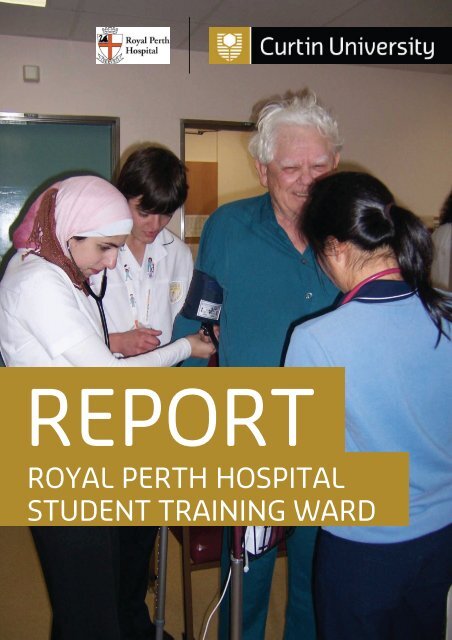
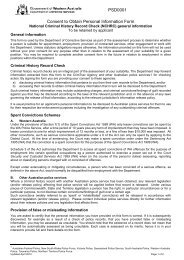
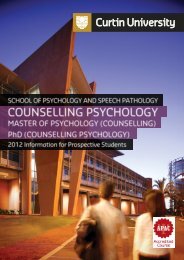
![Mental health commission report July 2010 - June 2011 [.pdf]](https://img.yumpu.com/50755705/1/184x260/mental-health-commission-report-july-2010-june-2011-pdf.jpg?quality=85)
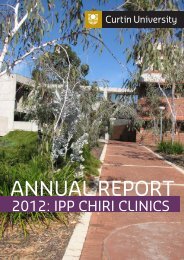
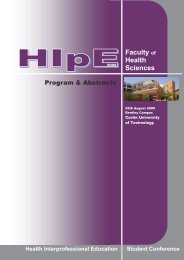

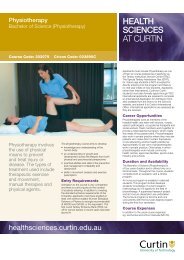
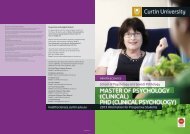
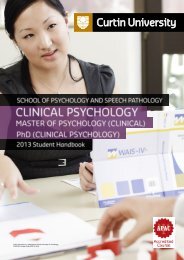

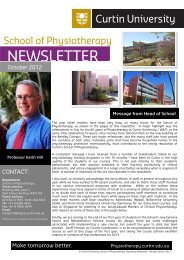
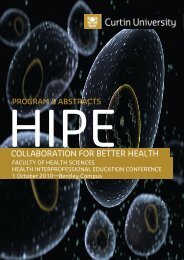
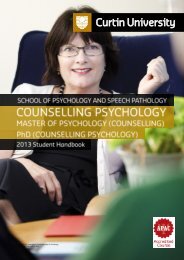
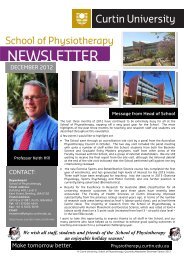
![2007 Annual Report [.pdf] - Health Sciences - Curtin University](https://img.yumpu.com/44476724/1/184x260/2007-annual-report-pdf-health-sciences-curtin-university.jpg?quality=85)